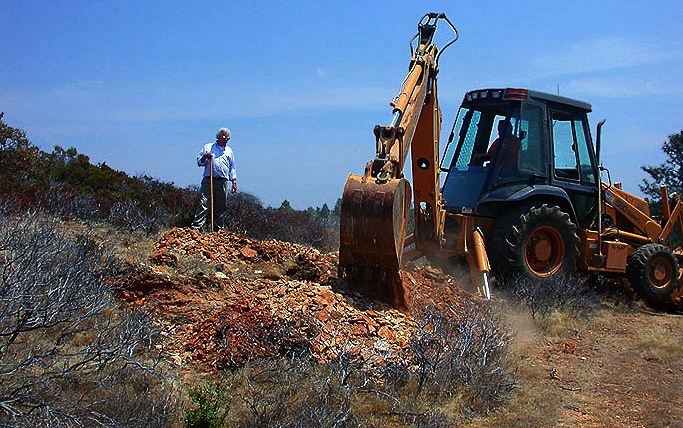
|
After finally securing a National Science Foundation grant to study the classic Eocene fossil floras of California's Sierra Nevada district, paleobotanist Howard Schorn (retired Collections Manager Of Fossil Plants at the University California Museum Of Paleontology in Berkeley) supervises a backhoe operator at a famous fossil plant locality, Lygodium Gulch (named after the common to abundant occurrence of a fossil climbing fern found there--a site I had discovered during one of my excursions to Ione Basin in 1992), Middle Eocene Ione Formation, Ione Basin, California. The backhoe is exposing for ease of paleobotanical collecting one of the most important fossil leaf localities in California--a rare, essentially sea-level Eocene flora from the estuaries, rivers and floodplains adjacent to the vast inland sea that once flooded what is now the Great Central Valley of California during Eocene geologic times, some 50 to 40 million years ago. The fossil plants collected from the Ione Basin had been planned to be used by the late paleobotanist Dr. Jack A. Wolfe (retired member of the United States Geological Survey) to help establish the paleoelevations and paleoclimate of the ancestral Sierra Nevada region during the Eocene Period of the Cenozoic Era. The image was snapped on July 30, 2002. Around mid July of 2002 I received a phone call from paleobotanist Howard Schorn. After much proverbial nail-biting, a proposed National Science Foundation grant to study the Eocene fossil floras of California's Sierra Nevada region had finally been approved. This was unexpected, but wondrously exciting news, indeed. Only a year earlier, I had learned that the NSF project had been denied by the "powers that be," as it were. Now, Howard wanted me to accompany him to Lygodium Gulch, the most prolific and easily accessible fossil plant locality in the Ione Basin, to spend a week collecting leaf fossils for the NSF study. He'd reserve rooms for us at a motel in Jackson, the County Seat of Amador County, California, for the week of July 27 to August 2, 2002. The basic plan of attack was to collect what we could without "killing ourselves" in the blazing, ultra-heated summer sun characteristic of that time of year in the western Mother Lode country. Howard figured that we would need to hire, eventually, a backhoe operator to better open up the primary fossil leaf quarry at famous Lygodium Gulch, due to the highly fractured nature of the fossiliferous Ione Formation near the surface. We needed to expose the largest blocks of fossil-bearing rocks possible--that way, we could with greater efficiency find whole, complete leaves for the late paleobotanist Dr. Wolfe (passed away in August, 2005), co-leader of the NSF project, who required at least 15 to 20 different leaf morphologies in order to score a fossil flora using his famous CLAMP analysis--that is, the Climate-Leaf Analysis Multivariate Program--whereby one uses the overall sizes, shapes and styles of leaf margins of fossil leaves to help determine the paleotemperatures and paleoelevations of a fossil flora. Please note: All fossil localities in the Ione Formation of Amador County, California, presently occur on private property; explicit permission from the land owners must be secured before collecting fossils there. |